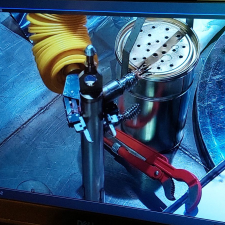The success of irradiation of materials in the ISHTAR capsule at the MARIA reactor
10-03-2022
The works carried out by the MARIA reactor team, related to the study of construction materials for the fourth generation helium-cooled reactors, have been successfully completed. The ISHTAR (Irradiation System for High-Temperature Reactors) capsule has been taken out of the reactor core, and the irradiated samples inside have been submitted for further study.

On Tuesday, February 22nd, reactor technicians from Nuclear Facilities Operations Department at NCBJ, cut open a capsule that had previously been in MARIA's core for several cycles. The irradiated graphite samples taken from the capsule have been sent for further research. This complicated operation has been carried out in the so-called hot chamber, a special box located next to the reactor basin, separated from the surroundings by a thick layer of heavy concrete and lead glass utilizing manipulators. The design of the probe had to not only withstand thermal gradients but also ensure that brittle graphite samples did not crack during the months of staying in the core.
„We designed from scratch, made and successfully irradiated the ISHTAR high-temperature capsule. It imitates the conditions prevailing in the core of one of the new types of reactors" – says Marek Migdal, task manager. "At the moment, this is a unique device on a European scale that allows the study of material damage caused by temperature 1000 ℃ and powerful neutron radiation”.
„The construction of our thermostatic capsule was multi-layered. As expected, we exceeded the yield point in its internal components, which caused them to bend. However, the special core of our construction ensured that it did not affect the delicate clepsidra-shaped samples intended for further graphite resistance tests" – comments Anna Talarowska, one of the device constructors. "We use the experience from its construction and operation for subsequent projects at the moment we are creating capsules for research on dielectrics used in fusion reactors”.
Currently, there are three installations with high-temperature HTGR reactors operating in the world: experimental - Japanese HTTR and Chinese HTR-10, and power reactor prototype HTR-PM developed based on the latter. The HTGR technology still requires research, especially in developing construction materials. Light water research reactors such as MARIA provide support for this type of research. The flux of neutrons in its core is about thirty times greater than in the prototype reactors mentioned above. As a result, thanks to unique capsules, we can observe the damage in materials during many decades of nuclear power plant operation much faster.
The ISHTAR thermostatic capsule was designed, manufactured and commissioned at NCBJ as part of the GoHTR project - "Preparation of legal, organizational and technical instruments for implementing HTR reactors". The project, with the participation of the Ministry of Climate and Environment, NCBJ and the Institute of Nuclear Chemistry and Technology, is implemented under the Strategic Program for Scientific Research and Development – GOSPOSTRATEG co-financed by the National Center for Research and Development.
For more information on the launch of the ISHTAR probe, see the article:




